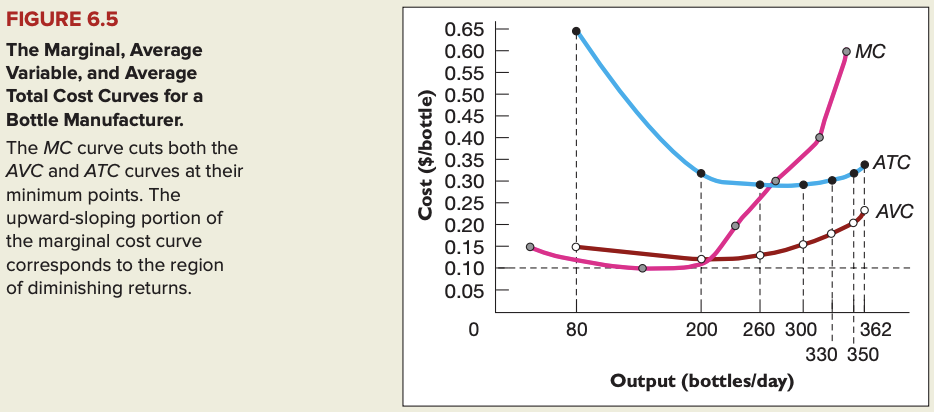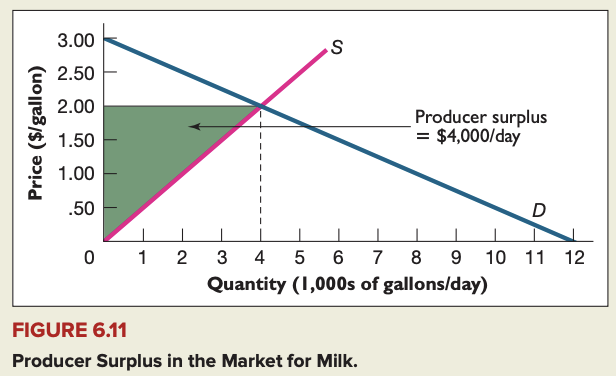
Chapter 6 - Perfectly competitive supply
Profit-maximizing firms in perfectly competitive markets
Profit: total revenue a firm receives from the sale of its product minus all costs - explicit and implicit - incurred in producing it.
Profit-maximizing firm: firm whose primary goal is to maximize the difference between its total revenues and total costs.
Perfectly competitive market: market in which no individual supplier has significant influence on the market price of the product.
Price taker: firm that has no influence over the price at which it sells its product.
Characteristics of markets that are perfectly competitive:
All firms sell the same standardized product.
The market has many buyers and sellers, each of which buys or sells only a small a fraction of the total quantity exchanged.
Productive resources are mobile.
Buyers and sellers are well informed.
That means they are aware of the relevant opportunities available to them.

Imperfectly competitive firm: firm that has at least some control over the market price of its product.
Factor of production: input used in the production of a good/service.
Short run: period of time sufficiently short that at least some of the firm's factors of production are fixed.
Long run: period of time of sufficient length that all the firm's factors of production are variable.
Law of diminishing returns: property of the relationship between the amount of a good/service produced and the amount of a variable factor required to produce it; the law says that when some factors of production are fixed, increased production of the good eventually requires ever-larger in creases in the variable factor.
Fixed factor of production: input whose quantity cannot be altered in the short run.
Variable factor of production: input whose quantity can be altered in the short run.
Fixed cost: sum of all payments made to the firm's fixed factors of production.
Variable cost: sum of all payments made to the firm's variable factors of production.
Total cost: sum of all payments made to the firm's fixed and variable factors of production.
Marginal cost: as output changes from one level to another, the change in total cost divided by the corresponding change in output.
Profit = Total revenue - Total cost
Profit = Total revenue - Variable cost - Fixed cost
Average variable cost (AVC): variable cost divided by total output.
Average total cost (ATC): total cost divided by total output.
Profitable firm: firm whose total revenue exceeds its total cost.

Determinants of supply revisited
Among the relevant factors causing supply curves to shift are:
New technologies
Changes in input prices
Changes in the number of sellers
Expectations of future price changes
Changes in the prices of other products that firms might produce
Supply and producer surplus
Producer surplus: amount by which price exceeds the seller's reservation price.

Chapter 6 - Perfectly competitive supply
Profit-maximizing firms in perfectly competitive markets
Profit: total revenue a firm receives from the sale of its product minus all costs - explicit and implicit - incurred in producing it.
Profit-maximizing firm: firm whose primary goal is to maximize the difference between its total revenues and total costs.
Perfectly competitive market: market in which no individual supplier has significant influence on the market price of the product.
Price taker: firm that has no influence over the price at which it sells its product.
Characteristics of markets that are perfectly competitive:
All firms sell the same standardized product.
The market has many buyers and sellers, each of which buys or sells only a small a fraction of the total quantity exchanged.
Productive resources are mobile.
Buyers and sellers are well informed.
That means they are aware of the relevant opportunities available to them.

Imperfectly competitive firm: firm that has at least some control over the market price of its product.
Factor of production: input used in the production of a good/service.
Short run: period of time sufficiently short that at least some of the firm's factors of production are fixed.
Long run: period of time of sufficient length that all the firm's factors of production are variable.
Law of diminishing returns: property of the relationship between the amount of a good/service produced and the amount of a variable factor required to produce it; the law says that when some factors of production are fixed, increased production of the good eventually requires ever-larger in creases in the variable factor.
Fixed factor of production: input whose quantity cannot be altered in the short run.
Variable factor of production: input whose quantity can be altered in the short run.
Fixed cost: sum of all payments made to the firm's fixed factors of production.
Variable cost: sum of all payments made to the firm's variable factors of production.
Total cost: sum of all payments made to the firm's fixed and variable factors of production.
Marginal cost: as output changes from one level to another, the change in total cost divided by the corresponding change in output.
Profit = Total revenue - Total cost
Profit = Total revenue - Variable cost - Fixed cost
Average variable cost (AVC): variable cost divided by total output.
Average total cost (ATC): total cost divided by total output.
Profitable firm: firm whose total revenue exceeds its total cost.

Determinants of supply revisited
Among the relevant factors causing supply curves to shift are:
New technologies
Changes in input prices
Changes in the number of sellers
Expectations of future price changes
Changes in the prices of other products that firms might produce
Supply and producer surplus
Producer surplus: amount by which price exceeds the seller's reservation price.

 Knowt
Knowt